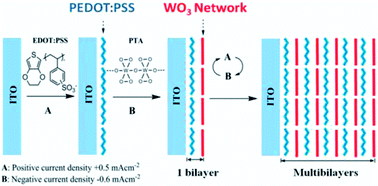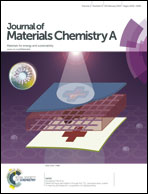One-pot sequential electrochemical deposition of multilayer poly(3,4-ethylenedioxythiophene):poly(4-styrenesulfonic acid)/tungsten trioxide hybrid films and their enhanced electrochromic properties†
Abstract
Hybrid thin films composed of multilayer poly(3,4-ethylenedioxythiophene):poly(4-styrenesulfonic acid) (PEDOT:PSS) and tungsten trioxide (WO3) were electrochemically deposited on indium tin oxide (ITO) from a one-pot solution using a square-wave galvanostatic method. The morphology of the hybrid thin films could be easily manipulated to optimize their electrochromic properties by adjusting deposition conditions. In the hybrids, both components can be simultaneously switched to coloured or bleached states. The hybrid film obtained with very short deposition times of PEDOT:PSS and WO3 in each cycle exhibits significantly enhanced electrochromic properties. The optical contrast of the hybrid film is higher than that of PEDOT:PSS or WO3 films of the same thickness. Moreover, the stability of the hybrid film is also drastically enhanced. The enhancement may be attributed to the favourable interactions between the two components, i.e., PEDOT:PSS may enter the defect sites in electrodeposited WO3, preventing surface-defect-induced anodic dissolution during cycling, while the surface functional groups of WO3 may act as dopants to inhibit over-oxidation of PEDOT, as well as the large interfacial area created using this unique one-pot multilayer deposition method.


 Please wait while we load your content...
Please wait while we load your content...